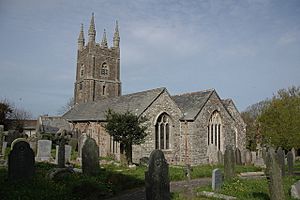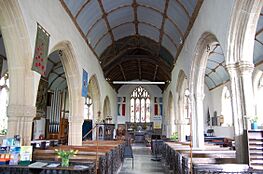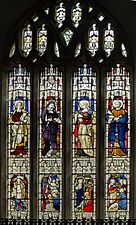St Olaf's Church, Poughill facts for kids
Quick facts for kids St Olaf's Church, Poughill |
|
|---|---|

St Olaf’s Church, Poughill
|
|
| 50°50′30.58″N 4°31′31.17″W / 50.8418278°N 4.5253250°W | |
| Location | Poughill |
| Country | Great Britain |
| Denomination | Church of England |
| Churchmanship | Conservative Evangelical |
| History | |
| Dedication | St Olaf |
| Administration | |
| Parish | Poughill |
| Deanery | Stratton |
| Archdeaconry | Bodmin |
| Diocese | Diocese of Truro |
| Province | Province of Canterbury |
St Olaf's Church is a historic Church of England church in the village of Poughill, near Bude in Cornwall, England. It is a Grade I listed building, which means it is considered a building of special architectural and historical importance and is protected by law.
The church is named after Olaf II of Norway, a Viking king who later became a saint. It has enough seats for 300 people.
Contents
History of the Church
St Olaf's Church is very old, with parts of it built over many centuries. The oldest parts that you can still see today were built in the 13th century.
How the Church Was Built
- The font, where babies are baptised, is the oldest part of the church, dating back to the 1200s.
- The south aisle (a hallway running alongside the main part of the church) was added in the 1300s and 1400s.
- The porch and the west tower were built in the 1400s.
- The strong, studded wooden door was made in the 1500s.
When the church was being repaired in 1928, workers found the foundations of an even older church from the Norman period (around the 11th century). However, none of the Norman building remains above ground today.
The pillars inside the church are made from two different types of stone. The pillars on the north side are made of Caen stone, a creamy-yellow limestone from France, and were built in the 14th century. The pillars on the south side are made of local granite and were added in the 15th century.
The Amazing Wall Paintings
One of the most famous features of St Olaf's is a large wall painting, or fresco. This painting was created around the year 1470 and shows the story of St Christopher.
For many years, no one knew the painting was there. It was covered over with whitewash in 1550 during a time called the Reformation, when King Edward VI ordered that decorations in churches should be removed. The painting was finally rediscovered in 1894.
According to legend, St Christopher was a giant who wanted to serve the greatest king of all. A wise man told him to help people cross a dangerous river. One night, a child asked for help crossing. As Christopher carried the child, he became heavier and heavier. The child then revealed he was Jesus, carrying the weight of the world. The painting in the church shows this powerful story.
Church Features
The Organ
The church has a pipe organ. You can find more details about its specific design on the National Pipe Organ Register.
Vicars of the Church
A vicar is a priest in charge of a parish. One notable vicar of St Olaf's was Percy Ashford, who later became the Chaplain General of Prisons, the head of all prison chaplains.



